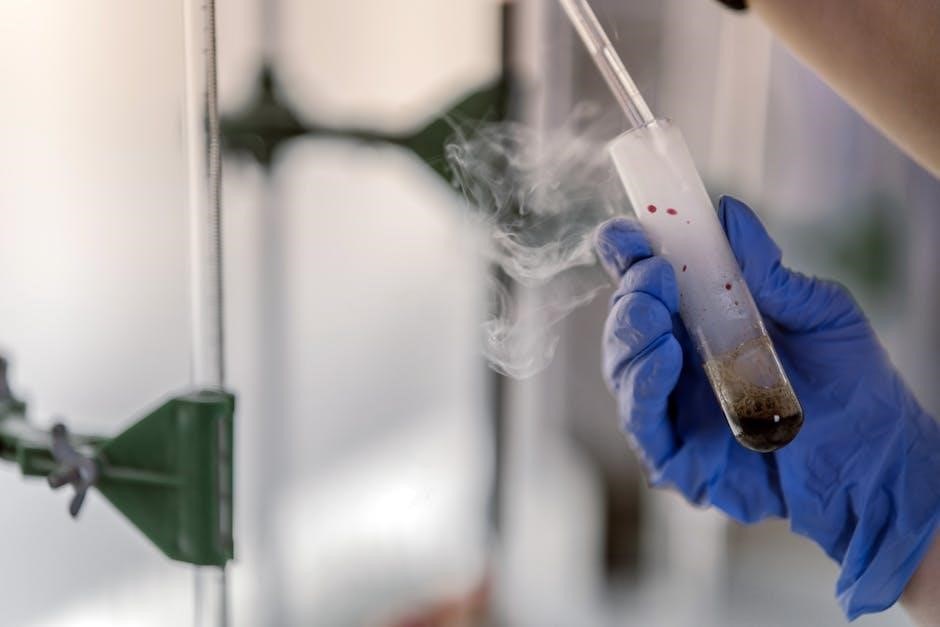
Insulation resistance testing is a critical diagnostic method to assess the condition of electrical insulation in cables, motors, and transformers․ It ensures safety, detects deterioration, and verifies compliance with standards․ A free downloadable PDF guide provides detailed procedures, best practices, and interpretation of results, serving as an essential resource for maintaining electrical systems efficiently․
Definition and Importance
Insulation resistance testing measures the resistance of insulation between conductive parts using an applied DC voltage․ It is a non-destructive method to evaluate the condition and integrity of electrical insulation in cables, motors, and transformers․ This test is crucial for ensuring electrical safety, detecting insulation deterioration, and preventing potential failures․ By identifying weaknesses early, it helps maintain system reliability, reduces maintenance costs, and ensures compliance with electrical standards․ Regular testing is essential for predicting system failures and optimizing electrical performance in industrial and residential applications․
Overview of the Test Procedure
The insulation resistance test procedure involves measuring the resistance of insulation materials using a DC voltage source․ Key steps include preparing the equipment, ensuring all conductive parts are isolated, and applying a high DC voltage․ The resistance is then measured and recorded․ The test helps identify insulation weaknesses, moisture, or contamination․ Results are interpreted to determine if the insulation meets safety standards․ A free downloadable PDF guide provides detailed step-by-step instructions, ensuring accurate and efficient testing for various electrical systems, from cables to industrial equipment․
Purpose and Significance of Insulation Resistance Testing
Insulation resistance testing ensures electrical safety, detects insulation deterioration, and verifies compliance with standards, critical for preventing failures and maintaining reliable electrical systems․
Ensuring Electrical Safety
Insulation resistance testing is vital for ensuring electrical safety by identifying potential faults in insulation that could lead to short circuits or electrical hazards․ By measuring resistance levels, the test helps detect weak points in the insulation, allowing for timely repairs․ This prevents accidents caused by electrical failures, ensuring a safer environment for both people and equipment․ Regular testing also helps maintain the integrity of electrical systems, reducing the risk of fires and other safety hazards․ A free downloadable PDF guide provides detailed procedures for conducting these tests safely and effectively․
Identifying Insulation Deterioration
Insulation resistance testing is a reliable method for identifying deterioration in insulation materials․ Over time, insulation can degrade due to factors like moisture, temperature, and aging, leading to reduced resistance levels․ By conducting regular tests, professionals can detect weak spots or areas where insulation has broken down․ This early detection prevents further damage and ensures the longevity of electrical systems․ The test results provide clear insights into the condition of insulation, enabling timely maintenance and repairs․ A free downloadable PDF guide offers step-by-step procedures for accurately identifying insulation deterioration․
Compliance with Electrical Standards
Insulation resistance testing ensures adherence to electrical safety standards, verifying that systems operate within specified parameters․ Regular testing helps meet regulatory requirements, preventing potential hazards and ensuring reliable operation․ The free downloadable PDF guide outlines procedures that align with industry standards, providing clear guidelines for compliance․ By following these standards, professionals can maintain safety, avoid legal issues, and ensure the integrity of electrical systems․ Compliance is crucial for both new installations and routine maintenance, guaranteeing long-term performance and safety․

Insulation Resistance Test Procedure
The insulation resistance test procedure involves measuring resistance using a megger or tester, applying DC voltage, connecting leads, and interpreting results for electrical system safety and integrity․ A free PDF guide details the steps and requirements for accurate testing, ensuring reliable outcomes․ This procedure is essential for assessing insulation condition and maintaining electrical system performance․ Proper execution ensures safety, accuracy, and compliance with industry standards, providing clear insights into insulation health․ Regular testing helps prevent failures and extends equipment lifespan․
Pre-Test Preparations
Before initiating the insulation resistance test, ensure all electrical equipment is de-energized and safely disconnected from power sources․ Remove any protective caps from cable ends and visually inspect for damage or contamination․ Ensure the test environment is stable, avoiding high humidity or extreme temperatures․ Calibrate the insulation resistance tester according to manufacturer guidelines․ Verify the condition of test leads and probes to ensure accurate measurements․ Prepare a safe workspace, adhering to personal protective equipment requirements․ Document all pre-test conditions and equipment details for reference during analysis․ Proper preparation ensures reliable test results and operational safety․
Conducting the Test
Connect the insulation resistance tester to the equipment under test, ensuring all terminals are securely linked․ Apply the recommended DC voltage, typically between 500V to 1000V, depending on the equipment’s voltage rating․ Measure the resistance over a specified duration, usually one minute, to account for absorption effects․ Record the initial and final resistance values, noting any significant drops that may indicate insulation degradation․ Monitor leakage currents, as excessive levels can signal potential issues․ The test confirms the insulation’s ability to withstand voltage stress, ensuring operational safety and reliability․ Always follow the tester’s instructions for accurate results․
Interpreting Test Results
Test results indicate the insulation’s condition by measuring resistance levels․ High resistance values suggest good insulation, while low values may signal degradation or moisture ingress․ Leakage currents should also be analyzed, as excessive levels can indicate potential faults․ Results are categorized as pass, fail, or marginal, based on predefined standards․ For example, a resistance reading below 1 MΩ at 500V typically indicates a failed test․ These interpretations guide maintenance decisions, such as insulation replacement or further diagnostic testing․ Accurate interpretation ensures reliable equipment operation and safety, aligning with industry standards and best practices outlined in the free PDF guide․
Tools and Equipment Required
Key tools include an insulation resistance tester, high-voltage DC source, test leads, and probes․ These ensure accurate measurements and safe testing of electrical insulation systems, as detailed in the free PDF guide․
Insulation Resistance Tester
An insulation resistance tester is a critical tool for measuring the resistance of electrical insulation․ It applies a high DC voltage to assess the integrity of insulation in cables, motors, and transformers․ Modern testers offer digital accuracy, memory storage, and safety features․ Regular calibration ensures reliable results․ The free PDF guide provides detailed operation tips and troubleshooting techniques for optimal use․ This tool is essential for diagnosing insulation faults and ensuring compliance with electrical safety standards․
High Voltage DC Source
A high voltage DC source is essential for insulation resistance testing, providing the necessary voltage to measure insulation integrity․ Typically, voltages range from 500V to 1000V or higher, depending on the equipment under test․ The DC source ensures a stable output for accurate resistance measurements․ Safety precautions are crucial when handling high voltages․ The free PDF guide outlines proper usage, voltage selection, and connection procedures to ensure reliable test results and operator safety during the insulation resistance testing process․
Test Leads and Probes
Test leads and probes are critical components in insulation resistance testing, ensuring accurate measurements by connecting the tester to the equipment under test․ High-quality leads with proper insulation are essential to prevent interference and ensure safety․ The free PDF guide emphasizes the importance of using calibrated leads and probes, as poor connections can lead to inaccurate results․ Regular inspection and maintenance of these components are recommended to guarantee reliable test outcomes and operator safety during the insulation resistance testing process․

Factors Affecting Insulation Resistance
Temperature, humidity, contamination, and aging significantly impact insulation resistance․ The free PDF guide details how these factors influence test results and system reliability, ensuring accurate assessments․
Temperature and Humidity
Temperature and humidity significantly influence insulation resistance․ Higher temperatures reduce resistance, while moisture increases conductivity, lowering insulation quality․ The free PDF guide explains how environmental conditions affect test outcomes and system reliability, emphasizing the importance of controlling these factors during inspections to ensure accurate results and maintain electrical safety standards․
Contamination and Moisture
Contamination and moisture are key factors affecting insulation resistance․ Dust, dirt, and humidity can degrade insulation quality, leading to lower resistance values and potential failures․ The free PDF guide highlights the importance of clean, dry conditions during testing to ensure accurate results․ Moisture, in particular, significantly reduces insulation effectiveness, making it essential to control environmental conditions and use proper sealing techniques to maintain system reliability and safety․ Regular inspections and maintenance are crucial to mitigate these issues, as outlined in the downloadable resource․
Aging of Insulation Materials
Aging of insulation materials is a critical factor influencing their performance․ Over time, insulation degrades due to heat, chemicals, and environmental stress, reducing its resistance․ The free PDF guide emphasizes the importance of regular testing to monitor this deterioration․ As materials age, their ability to withstand voltage decreases, potentially leading to failures․ Understanding the aging process helps in scheduling timely maintenance and replacements, ensuring the reliability and safety of electrical systems․ The guide provides detailed insights and methods to assess and mitigate the effects of insulation aging effectively․

Safety Precautions
Always wear personal protective equipment (PPE) and ensure equipment is de-energized before testing․ Follow safety guidelines to avoid electrical shocks and ensure a safe testing environment․
Personal Protective Equipment
Wearing proper personal protective equipment (PPE) is crucial during insulation resistance testing to prevent electrical shocks and injuries․ This includes high-voltage gloves, safety glasses, and insulated tools․ Ensure all PPE meets ASTM or IEC standards for electrical safety․ Avoid loose clothing that could get caught in equipment․ Hard hats and flame-resistant apparel may also be necessary, depending on the testing environment․ Always follow manufacturer guidelines for PPE use and maintenance․ The free PDF guide provides detailed recommendations for selecting and using appropriate PPE during insulation resistance tests․
De-Energizing Equipment
De-energizing equipment is a critical safety step before performing insulation resistance tests․ Ensure all power sources are disconnected and the system is grounded to prevent accidental start-ups․ Use lockout/tagout procedures to secure the equipment, verifying it is safe to work on․ This step prevents electrical shocks and ensures a stable environment for testing․ The free PDF guide emphasizes the importance of proper de-energization and provides detailed procedures to follow․ Always confirm the system is in a zero-energy state using appropriate test instruments before proceeding with the insulation resistance test․
Working in Safe Environments
Creating a safe working environment is essential for conducting insulation resistance tests․ Ensure the area is clear of hazards and well-ventilated to prevent moisture buildup, which can affect test results․ The free PDF guide outlines strategies to minimize risks, such as using proper signage to alert others of ongoing tests․ Additionally, it emphasizes the importance of avoiding wet conditions and ensuring all equipment is properly insulated․ By following these guidelines, technicians can perform tests safely and accurately, ensuring reliable outcomes and adherence to safety standards․
Best Practices for Conducting the Test
Always follow manufacturer guidelines, ensure proper equipment calibration, and document test results accurately․ Refer to the free PDF guide for detailed procedures and best practices․
Following Manufacturer Guidelines
Adhering to manufacturer guidelines ensures accurate and safe insulation resistance testing․ These guidelines specify recommended test voltages, connection methods, and equipment settings․ They also outline preparation steps, such as removing sealing caps and suspending cables in free air․ Properly following these instructions helps prevent equipment damage and ensures reliable results․ Additionally, guidelines often include safety precautions, like using personal protective equipment and de-energizing systems before testing․ The free PDF guide provides detailed manufacturer-recommended procedures, ensuring compliance and optimal test outcomes․ Always refer to the specific manufacturer’s instructions for your equipment to maintain accuracy and safety․
Ensuring Proper Equipment Calibration
Proper calibration of insulation resistance testing equipment is essential for accurate results․ Before conducting tests, verify that the tester is calibrated according to the manufacturer’s specifications․ Use a known reference resistor or calibration certificate to confirm accuracy․ Regularly scheduled calibration ensures reliability and prevents measurement errors․ The free PDF guide provides detailed steps for calibrating equipment, including pre-test checks and post-test verification․ Proper calibration guarantees that the insulation resistance readings are trustworthy, ensuring the safety and integrity of the electrical system being tested․
Documenting Test Results
Accurate documentation of insulation resistance test results is crucial for maintaining records and ensuring compliance․ Record the date, equipment used, and environmental conditions like temperature and humidity․ Include the measured resistance values and any observations․ The free PDF guide provides templates and examples for clear documentation․ Properly documented results help in tracking insulation condition over time and support maintenance planning․ Ensure all data is stored securely for future reference and audits․ Clear documentation also facilitates communication among team members and stakeholders, ensuring everyone is informed about the system’s status․

Common Applications of Insulation Resistance Testing
Insulation resistance testing is widely used for electrical cables, transformers, motors, and industrial systems․ The free PDF guide details its application in ensuring equipment reliability and safety․
Electrical Cables and Wires
Electrical cables and wires are crucial components in electrical systems, requiring regular insulation resistance testing to ensure their integrity․ The free PDF guide outlines procedures for testing these components, emphasizing the importance of maintaining proper insulation to prevent failures and ensure safe operation․ It provides step-by-step instructions and best practices for conducting tests, helping technicians identify potential issues early and maintain system reliability․ The guide is an essential resource for anyone involved in electrical maintenance and safety․
Transformers and Motors
Insulation resistance testing is vital for transformers and motors to ensure the integrity of their windings and prevent premature failure․ The free PDF guide provides detailed procedures for testing these components, including step-by-step instructions and interpretation of results; Regular testing helps detect insulation deterioration early, ensuring operational safety and reliability․ The guide also covers best practices for maintenance and troubleshooting, making it an indispensable resource for technicians and engineers working with electrical equipment․ By following the outlined procedures, professionals can extend the lifespan of transformers and motors, reducing downtime and enhancing overall system performance․
Industrial Electrical Systems
In industrial settings, insulation resistance testing ensures the reliability and safety of electrical systems․ The free PDF guide offers comprehensive procedures tailored for industrial applications, emphasizing the importance of regular testing to prevent failures․ It covers techniques for assessing insulation in complex networks, ensuring compliance with industry standards․ By adhering to the guidelines, professionals can maintain system integrity, reduce downtime, and optimize energy efficiency․ The guide is a valuable tool for maintaining industrial electrical systems, promoting operational excellence and safety․
Interpreting Test Results
The free PDF guide simplifies understanding insulation resistance values, helping identify potential failures and ensure system reliability․ It provides clear criteria for interpreting test outcomes effectively․
Understanding Resistance Values
Resistance values indicate the insulation’s ability to resist electrical current leakage․ Higher values typically signify better insulation quality, while lower values may point to deterioration or moisture issues․ The free PDF guide explains how to interpret these values, ensuring accurate assessment of insulation condition․ It also covers the impact of voltage levels on measurements and provides practical examples for clearer understanding․ By analyzing resistance values, technicians can identify potential faults early, ensuring electrical safety and system reliability․ The guide serves as a valuable tool for applying these principles effectively in real-world scenarios․
Identifying Failures
Identifying failures during insulation resistance testing involves analyzing unusual resistance readings․ Low resistance values may indicate insulation breakdown or moisture intrusion․ The free PDF guide outlines common failure patterns and provides troubleshooting tips․ It emphasizes the importance of comparing test results with baseline values to detect anomalies․ By recognizing these signs, technicians can pinpoint faulty components, such as damaged cables or winding insulation, ensuring timely repairs․ This proactive approach helps prevent equipment failure and enhances overall system reliability and safety, as detailed in the comprehensive guide․
Developing Maintenance Strategies
Insulation resistance test results are crucial for developing effective maintenance strategies․ By analyzing data over time, trends indicating gradual insulation deterioration can be identified․ The free PDF guide provides insights into creating proactive maintenance plans, ensuring equipment longevity․ It recommends scheduling tests based on usage and environmental conditions․ Regular testing helps prioritize repairs, reducing unexpected failures․ The guide also offers templates for tracking test history and setting thresholds for intervention․ This structured approach ensures optimal system performance and safety, aligning maintenance efforts with operational needs, as outlined in the detailed resource․
Free PDF Download of the Procedure
A free PDF guide on insulation resistance testing provides detailed procedures, safety tips, and result interpretation․ It’s a valuable resource for professionals and DIYers alike, ensuring accurate and safe testing․
Availability and Benefits
The insulation resistance test procedure PDF is widely available online for free download․ It offers step-by-step instructions, safety protocols, and interpretation guidelines, making it indispensable for professionals and DIY enthusiasts․ The guide ensures compliance with industry standards, helping users maintain electrical systems safely and efficiently․ By following the outlined procedures, individuals can identify insulation issues early, preventing potential failures and enhancing system reliability․ This accessible resource is a must-have for anyone aiming to conduct accurate and safe insulation resistance testing․
Contents of the PDF Guide
The free insulation resistance test procedure PDF guide includes detailed step-by-step instructions for conducting tests safely and effectively․ It covers pre-test preparations, equipment requirements, and test execution protocols․ The guide also provides examples of test result interpretation, helping users understand resistance values and identify potential failures․ Additional sections focus on safety precautions, calibration of equipment, and best practices for documenting results․ Visual aids like diagrams and checklists are often included to enhance clarity․ This comprehensive resource ensures that users can perform insulation resistance testing with confidence and accuracy, adhering to industry standards․
How to Access the Free Resource
To access the free insulation resistance test procedure PDF, visit the official website or authorized resource portal․ Locate the download section and click on the provided link․ Fill in the required details, if prompted, and confirm your request․ The guide will be sent to your email or available for immediate download․ Ensure your device has a PDF reader installed to view the document․ This resource is often free of charge and requires no registration, making it easily accessible for professionals and DIY enthusiasts alike․ Downloading ensures you have a handy reference for conducting tests accurately․
The insulation resistance test procedure PDF is a valuable resource for understanding and performing the test, ensuring electrical safety and system reliability with comprehensive guidance․
The insulation resistance test procedure PDF offers a comprehensive guide to evaluating electrical insulation integrity․ It outlines step-by-step methods, safety protocols, and result interpretation․ The document covers essential tools like megohmmeters and test leads, while emphasizing factors influencing results, such as moisture and temperature․ By following the PDF, technicians can ensure compliance with standards and maintain electrical system reliability․ This free resource is invaluable for professionals seeking to enhance safety and efficiency in insulation testing across various applications․
Final Thoughts on Insulation Resistance Testing
Insulation resistance testing is a vital tool for ensuring electrical safety and system longevity․ The free downloadable PDF guide provides a clear, structured approach to conducting tests, interpreting results, and maintaining equipment․ By adhering to the outlined procedures, professionals can identify potential issues early, reducing risks and costs․ This resource underscores the importance of regular testing and serves as a comprehensive reference for anyone involved in electrical maintenance, making it an indispensable asset for both novices and experienced technicians alike․